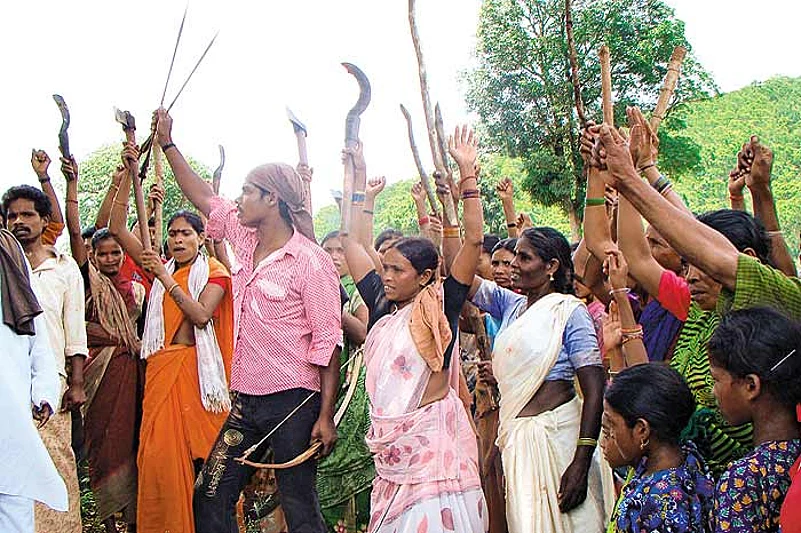Mine Menace
- Two aluminium plants, of AnRaK and Jindal South West, coming up in tribal areas of Visakhapatnam
- APMDC will mine and supply them bauxite ore from some 3,600 ha of forested hills, home to tribals
- 2 lakh tribals from 270 villages (66 in Jerrala alone) likely to be affected, directly or indirectly
- Tremendous environmental damage feared, including that to rivers Sarada, Gosthani and Sileru and the Raiwada and Thatipudi reservoirs
- Protests growing in strength
***
The hills and valleys are as scenic, their tribal inhabitants as abject, the industrial interests threatening them as powerful and rapacious. But, despite considerable mobilisation and the larger numbers of lives facing disruption, the resistance of tribals in Andhra Pradesh seems to have drawn less attention than that of the Dongria Kondh of Orissa against the Vedanta group. Like Orissa’s Kalahandi district, one of the country’s poorest, tribal homelands nestling between the Eastern Ghats and the coast in Visakhapatnam district have attracted the steel claws of mining machines seeking bauxite to feed two giant aluminium plants coming up in the area.
The agitating tribals have almost given up hope. They remained unconvinced when Union rural development minister Jairam Ramesh and Union tribal welfare & panchayati raj minister Kishore Chandra Deo promised to halt the mining onslaught during a recent visit to inaugurate ration shops. After all, it was when Jairam was Union minister for environment & forests that in-principle agreement for diversion of forest land was granted. The agitation, though, has been on for some months now. On December 21-22, some 1,000 people armed with bows and arrows blockaded an MOEF team that came to study the impact of mining on tribal livelihoods. The team made do with an aerial survey!
Mining—to be carried out by the Andhra Pradesh Minerals Development Corporation (APMDC), which will supply ore to the plants—is yet to begin. But the panic among tribals has heightened of late: one of the plants, of AnRaK Aluminium Ltd, on 1,900 acres in Makavarapalem mandal, is nearing completion. They see this as a sign that mining—and the spoiling of tribal lands—is imminent.
AnRaK is a joint venture of the Andhra-based Penna group of industries and the Ras al-Khaimah Investment Authority. It was created through a 2007 MOU between the governments of Andhra Pradesh and the Ras al-Khaimah emirate. The other plant, yet to be built, has been planned through a 2005 MOU between the government and Jindal South West. Both groups have been granted rights to bauxite from nests of biodiversity.
AnRaK will be supplied from Chintapalli, which the MOEF had in 2010 suggested be declared a “biosphere reserve”. (The idea was nixed by the state government.) The Jindal plant is to get bauxite from Araku, a range of forested hills and valleys. Both areas are in Visakhapatnam district and, like East Godavari, the other bauxite-rich district of Andhra, home to the Kondh, Nooka Dora, Bagata and Manne Dora tribals, engaged in slash-and-burn cultivation, collection of forest produce or labour on coffee plantations.
Besides acreage for the plant, AnRaK has obtained rights to bauxite from 1,162 hectares for 30 years. It will draw on reserves in the Jerrala hills of Chintapalli. Similarly, Jindal South West has obtained 1,700 fertile acres in Srungavarapu Kota for its plant, and rights to 240 million tonnes of ore from 2,446 ha in Gallikonda, Raktakonda and Chittamgondi hills in Araku. It will also get ore from the Sapparla hills. APMDC MD Mukesh Kumar Meena is confident of seeing things through. He says MOEF clearance for mining in Araku and Sapparla is awaited, but first-stage clearance for Chintapalli has been obtained. “Only second-stage clearance is awaited,” he told Outlook. These 5,000 hectares hold some of the state’s finest bauxite reserves. They’re also shaded by mixed deciduous forests, and inhabited by tribals. Nearly 80 per cent of this has been opened to ravage.
It’s a little difficult to visualise the enormous human impact, always understated by industry and the state. But a comparison to the Vedanta project might help. Mining in Orissa’s Niyamgiri hills would displace 14 villages of the Dongria Kondh, some 10,000 people. In contrast, mining for the two plants in Visakhapatnam threatens 270 villages and, according to estimates by Samata, a voluntary group, will affect 2 lakh people directly or indirectly. “Displacement can’t be quantified just in terms of physical eviction,” says R. Ravi of Samata. “We must also look at the destruction of productive forest areas. APMDC is acting as no more than a front for these firms. There’ll be gradual takeover of the area by AnRaK and Jindal South West. Much more than just mineral wealth will be lost.”
The environmental impact might be easier to picture. Since the deposits are on hills 900-1,400 metres high, the hillsides will have to be scarred, scraped, eroded down. Wastage is tremendous: the aluminium-to-ore ratio is about 1:6. The red residue is heaped in pits lined with plastic sheet, but leakage, and washout during rains, can be tremendous, muddying streams and rivers, spoiling aquifers and reservoirs. Besides, the plants will use some 18 million gallons water per day, about half of Visakhapatnam city’s daily consumption, by one estimate. Another residue from the electrolytic process, waste caustic soda, can wreak havoc with the soil and water systems. “The damage will be irreparable,” says V.S. Krishna of the Human Rights Forum. “Gallikonda and Raktakonda are catchments for the Sarada and Gosthani rivers, Jerrala for the Sileru.”
Like Jairam and Deo (see box), Andhra’s tribal welfare minister P. Balaraju is also opposed to the mining and says he will tell the state government to cancel the mining leases. The trouble is, his good intentions come perhaps too late.


























